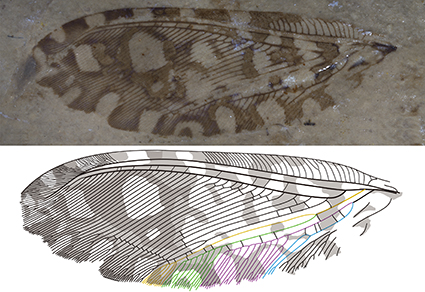Abstract
A new genus with a new species, Fuscopolystoechotes reticulatus Xu, Zheng, Shih & Wang, gen. et sp. nov., and a new species Lichenipolystoechotes fenestratus Xu, Fang, Shih & Wang, sp. nov. of Ithonidae, are described from the Middle Jurassic Jiulongshan Formation, Inner Mongolia, China. Both new species are assigned to Polystoechotes genus-group mainly based on the combination of following characters: the distinctly narrowed costal space in distal half, presence of recurrent humeral veinlet and ScA, absence of interlinked crossveins in between costal crossveins, converged ScP and RA and pectinately branched MA and MP in distal. But the new genus of Fuscopolystoechotes gen. nov. is differentiated from all other genera by a combination of characters, i.e., specialized markings on forewing; scp-ra crossveins absent; CuP with pectinate branches and crossveins in RP–A area complicated. These two new species with the remarkable markings in forewings are considered to be adapted for the particular Mesozoic environments for camouflage or mimicry.
References
Andersen, S. (2001) Silky lacewings (Neuroptera: Psychopsidae) from the Eocene-Paleocene transition of Denmark with a review of the fossil record and comments on phylogeny and zoogeography. Insect Systematics & Evolution, 32, 419–438. https://doi.org/10.1163/187631201X00290
Archibald, S.B. & Makarkin, V.N. (2006) Tertiary giant lacewings (Neuroptera: Polystoechotidae): revision and description of new taxa from Western North America and Denmark. Journal of Systematic Palaeontology, 4 (2), 119–155. https://doi.org/10.1017/S1477201906001817
Breitkreuz, L.C.V., Winterton, S.L. & Engel, M.S. (2017) Wing tracheation in Chrysopidae and other Neuropterida (Insecta): a resolution of the confusion about vein fusion. American Museum Novitates, 3890, 1–44. https://doi.org/10.1206/3890.1
Burmeister, H.C.C. (1839) Handbuch der entomologie. Zweiter Band. Besondere Entomologie. Zweite Abtheilung. Kaukerfe. Gymnognatha. (Zweite Hälfte; vulgo Neuroptera). Enslin, Berlin, pp. 757–1050.
Carpenter, F.M. (1940) A revision of the Nearctic Hemerobiidae, Berothidae, Sisyridae, Polystoechotidae and Dilaridae (Neuroptera). Proceedings of the American Academy of Arts and Sciences, 74, 193–280. https://doi.org/10.2307/20023398
Fang, H., Labandeira, C.C., Ma, Y.M., Zheng, B.Y., Ren, D., Wei, X.L., Liu, J.X. & Wang, Y.J. (2020) Lichen mimesis in mid-Mesozoic lacewings. eLife, 9, e59007. https://doi.org/10.7554/eLife.59007
Khramov, A.V., Liu, Q. & Zhang, H.C. (2019) Mesozoic diversity of relict subfamily Kempyninae (Neuroptera: Osmylidae). Historical Biology, 31, 938–946. https://doi.org/10.1080/08912963.2017.1411351
Labandeira, C.C., Yang, Q., Santiago-Blay, J.A., Hotton, C.L., Monteiro, A., Wang, Y.J., Goreva, Y., Shih, C.K., Siljeström, S., Rose, T.R., Dilcher, D.L. & Ren, D. (2016) The evolutionary convergence of mid-Mesozoic lacewings and Cenozoic butterflies. Proceedings of the Royal Society B, 283, 20152893. https://doi.org/10.1098/rspb.2015.2893
Lu, X.M., Zhang, W.W., Ohl, M. & Liu, X.Y. (2017) The first moth lacewing (Insecta: Neuroptera: Ithonidae) from the mid-Cretaceous amber of Myanmar. Cretaceous Research, 78, 78–83. https://doi.org/10.1016/j.cretres.2017.05.027
Ma, Y.M., Shih, C.K., Ren, D. & Wang, Y.J. (2020) New lance lacewings (Osmylidae: Kempyninae) from the Middle Jurassic of Inner Mongolia, China. Zootaxa, 4822 (1), 94–100. https://doi.org/10.11646/zootaxa.4822.1.4
Makarkin, V.N., Wedmann, S. & Weiterschan, T. (2014) First record of the family Ithonidae (Neuroptera) from Baltic amber. Zootaxa, 3796 (2), 385–393. https://doi.org/10.11646/zootaxa.3796.2.10
Martynov, A.V. (1925) To the knowledge of fossil insects from Jurassic beds in Turkestan. 2. Raphidioptera (continued), Orthoptera (s.l.), Odonata, Neuroptera. Izvestia Rossiiskoi Akademii Nauk, 19, 569–598.
Martynov, A.V. (1937) Liassic insects from Shurab and Kisyl-Kiya. Trudy Paleontologicheskogo Instituta, 7, 1–178. [in Russian]
Navás, L. (1931) Insectos de Papudo (Aconcagua) recogidos por don Arturo Fontecilla en Febrero de 1930. Revista Chilena de Historia Natural, 35,71–73.
Oswald, J.D. (2007) A new replacement name for Pterocalla Panfilov, 1980 (Neuroptera: Polystoechotidae), a junior homonym of Pterocalla Rondani, 1848 (Diptera: Ulidiidae). Proceedings of the Entomological Society of Washington, 109, 257–258.
Özdikmen, H. (2009) A substitute name for a genus of fossil Neuroptera. Munis Entomology & Zoology, 4, 289–290.
Panfilov, D.V. (1980) New representatives of lacewings (Neuroptera) from the Jurassic of Karatau. In: Dolin, V.G., Panfilov, D.V., Ponomarenko, A.G. & Pritykina, L.N. (Eds.), Fossil insects of the Mesozoic. Naukova Dumka, Kiev, pp. 82–111. [in Russian]
Ponomarenko, A.G., Aristov, D.S., Bashkuev, A.S., Gubin, Y.M., Khramov, A.V. Lukashevich, E.D., Popov, Y.A., Pritykina, L.N., Sinitsa, S.M., Sinitshenkova, N.D., Sukacheva, I.D., Vassilenko, D.V. & Yan, E.V. (2014) Upper Jurassic Lagerstätte Shar Teg, Southwestern Mongolia. Paleontological Journal, 48, 1573–1682. https://doi.org/10.1134/S0031030114140160
Ren, D., Engel, M.S. & Lü, W. (2002) New giant lacewings from the Middle Jurassic of Inner Mongolia, China (Neuroptera: Polystoechotidae). Journal of the Kansas Entomological Society, 75, 188–193.
Ren, D., Shih, C.K., Gao, T.P., Wang, Y.J., & Yao, Y.Z. (2019) Rhythms of Insect Evolution-Evidence from the Jurassic and Cretaceous in Northern China. Wiley Blackwell, Hoboken, New Jersey, 710 pp. https://doi.org/10.1002/9781119427957
Ruxton, G.D., Sherratt, T.N. & Speed, M.P. (2004) Avoiding attack: the evolutionary ecology of crypsis, warning signals, and mimicry. Oxford University Press, Oxford, 249 pp.
Scudder, S.H. (1895) Canadian fossil insects, myriapods and arachnids, 1. The tertiary Hemiptera of British Columbia. Geological Survey of Canada Contributions to Canadian Palaeontology, 2 (1), 5–26. https://doi.org/10.4095/106568
Shcherbakov, D.E. (2006) The earliest find of Tropiduchidae (Homoptera: Auchenorrhyncha), representing a new tribe, from the Eocene of Green River, USA, with notes on the fossil record of higher Fulgoroidea. Russian Entomological Journal, 15 (3), 315–322.
Wang, Y.J., Liu, Z.Q., Wang, X., Shih, C.K., Zhao, Y.Y., Engel, M.S. & Ren, D. (2010) Ancient pinnate leaf mimesis among lacewings. Proceedings of the National Academy of Sciences, 107 (37), 16212–16215. https://doi.org/10.1073/pnas.1006460107
Winterton, S.L. & Makarkin, V.N. (2010) Phylogeny of moth lacewings and giant lacewings (Neuroptera: Ithonidae, Polystoechotidae) using DNA sequence data, morphology and fossils. Annals of the Entomological Society of America, 103 (4), 511–522. https://doi.org/10.1603/AN10026
Yang, Q., Shi, C.F., Pang, H. & Ren, D. (2019) A new genus of giant lacewing (Insecta, Neuroptera, Ithonidae) from the Middle Jurassic of China. Zootaxa, 4613 (2), 375–378. https://doi.org/10.11646/zootaxa.4613.2.11
Yang, Q., Wang, Y.J., Labandeira, C.C., Shih, C.K. & Ren, D. (2014) Mesozoic lacewings from China provides phylogenetic insight into evolution of the Kalligrammatidae (Neuroptera). BMC Evolutionary Biology, 14 (1), 126. https://doi.org/10.1186/1471-2148-14-126
Zheng, B.Y., Ren, D. & Wang, Y.J. (2016a) Earliest true moth lacewing from the Middle Jurassic of Inner Mongolia, China. Acta Palaeontologica Polonica, 61 (4), 847–851. https://doi.org/10.4202/app.00259.2016
Zheng, B.Y., Ren, D. & Wang, Y.J. (2016b) A new species of Lasiosmylus from the Early Cretaceous, China clarifies its genus-group placement in Ithonidae (Neuroptera). Zookeys, 636, 41–50. https://doi.org/10.3897/zookeys.636.10103

